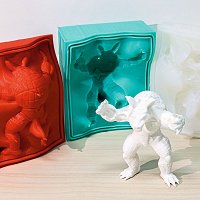Moulding a mould: A new technique for creating silicone moulds
01.10.2018
Silicone moulds are great for small-series production of, for example, educational parts, jewellery or art. Producing them, however, is difficult. Complex objects require a lot of experience and manual work. Scientists have now found a way to create the moulds faster and cheaper.
 The method of fabricating objects via silicone moulding has a long tradition. Until now, however, creating moulds for casting complex objects required a lot of experience and still involved manual work, which made the process expensive and slow.
The method of fabricating objects via silicone moulding has a long tradition. Until now, however, creating moulds for casting complex objects required a lot of experience and still involved manual work, which made the process expensive and slow.
Researchers from the Istituto di Scienza e Tecnologie dell’Informazione (ISTI-CNR), an Institute of the National Research Council of Italy, and the Institute of Science and Technology Austria (IST Austria) have now developed a tool that not only automatically finds the best way of designing the moulds but also delivers templates for so-called “metamoulds”: rigid moulds that are 3D-printed and used to fabricate the optimised silicone moulds. Their method, which can lower the cost of this fabricating technique, will be presented at this year’s prestigious Siggraph conference where IST Austria researchers are involved in a total of five presentations. ACM Siggraph is an international community of researchers, artists, developers and business professionals who share an interest in computer graphics and interactive techniques. The organisation holds the annual Siggraph conference on the theory and practice of computer graphics and interactive techniques, inspiring progress through education, excellence, and interaction.
Silicone moulding is no longer a craft only for experts
When it comes to fabricating a series of identical objects, the technique of moulding is plays an important role. A popular material for the mould is silicone, as it is deformable and therefore forgiving when it comes to extracting complex objects from the mould at the end of the fabrication process. Extracting the object from the mould generally requires deciding on a direction in which the mould pieces can be separated without getting caught in overhanging parts of the object. A careful cut needs to be placed to open the mould. This process, which until now involved manual work from an experienced craftsman, has now been automated.
“Until now, silicone moulding of complex shapes was a craft that needed years of experience and a skillful hand. You needed to know where to place the cuts ideally and the work was done manually. Our new tool makes this method accessible to everyone,” says Bernd Bickel.
The user only needs to upload the desired shape to the computer. The tool then helps in two steps: First, it calculates where the cuts need to be placed for an optimal result. This means that the smallest possible number of mould pieces is used and that the object can be safely removed from the mould once it is finished. Then the computer goes one step further: It automatically creates 3D-printable templates of the metamould, a container that is used to fabricate the ideal silicone mould pieces. The printed metamoulds are filled with liquid silicone to produce the final silicone mould pieces, which are reusable and make it possible to cast multiple replicas.
Method of choice for small-series production
The researchers expect that their method will prove very useful for small series, for example, in jewellery design or art. “When you are not producing millions of copies, then this is the method of choice,“ says Thomas Alderighi from ISTI-CNR, the first author of the study who has spent two months at IST Austria as an intern in the research group of Bernd Bickel.
As noted by Paolo Cignoni, research director at ISTI – CNR, an interesting field of application is the production of a small number of replicas for museums that could be handled by visitors for a deeper experience of the exhibition.
The final silicone mould pieces can then be used to create replicas from a variety of different materials, including traditional ones like various types of resin, but also unconventional ones like chocolate or ice.













































